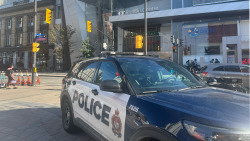A recent IPSOS survey showing that a majority of Canadians fear increased incidents of violence are likely, is being confirmed by community leaders in Ottawa who say they feel their communities are concerned about rising crime and looking to officials for solutions.
But some say expecting police to address these issues is a waste of time.
“I do believe, because we see it in the news every day, there is an increase in violent crime,” said Adrienne Stevenson, board member for the Alta Vista Community Association. “We certainly see a lot of reports of violent crime and I know it exists,”
“I do think it’s a concern, a community concern and I think we need to put resources towards it that are enough to help to keep it at the lowest level possible.”
From 2020 to 2021, the city saw a 6.8 per cent increase in crime rate, and a 5.5 per cent increase in violent crimes. Those numbers continued to surge in 2022, with a 22 per cent rise in the city’s crime rate, and a 9 per cent rise in violent crimes.
The magnitude and frequency of these crimes vary between communities. Some neighbourhoods, such as Stevenson’s, have seen an increase in property damage and theft, particularly of vehicles. Others, such as Centretown and Vanier, have had to deal with the highest crime rates in the city.
“There’s definitely a lot of concern, people are leery of things that go on,” said Myka Delisle-Spencley, chair for the Vanier Community Association safety committee, adding that she thinks a lot of it has to do with the pandemic.
“We’ve seen an increase, especially since the beginning of COVID because a lot of people lost their jobs, lost their homes and can’t make ends meet. Unfortunately that pushes people into desperate situations,” she said.
According to the IPSOS survey, 58 per cent of Canadians feel as though violence has risen since the COVID-19 pandemic first began.
The pandemic put an emphasis and stress on social issues such as poverty, mental health, and housing. Historically, lower-income neighbourhoods and families have been disproportionately affected by these problems, which have been exacerbated by the pandemic.
Ottawa has not been immune. Food banks, homeless shelters, and other social services have all struggled with increased demand, leaving certain communities searching for answers.
“In a lot of the apartments and condos now we have people who don’t have homes who are sleeping in the entrance ways and we didn’t have those same numbers, even six or seven years ago,” said Brenda Knight, executive member of the Centretown Community Association.
“I don’t care who you are, these are Maslow’s hierarchy of needs, they’re the basic ones. If you don’t have them, you’re gonna try to get them, however you can.”
Looking for solutions
Community members have been turning to their elected officials, including municipal leaders, for ways to address these issues. There is a sense, however, among these communities, that the city isn’t doing enough to mitigate growing problems and their priorities need to be realigned.
“The city, in my opinion, is doing nothing,” said Knight. “The priority of dollars that should be spent, by our council, should be directed towards those who don’t have homes, should be directed towards affordable housing.”
“Not sitting, even discussing, wasting our tax dollars on building a hotel out by the airport.”
Some point to Glasgow, Scotland, as a model for tackling these issues. Glasgow, formerly known as Europe’s murder capital, started treating crime and violence as a public health crisis. They implemented a violence reduction unit, and started tackling violence at the root of its causes, listening to professionals and experts along the way. Many jurisdictions still approach this as an issue for the police to address.
“You now get people realizing that increasing the police budget is not gonna make people safer. They make people feel safer in the short-term, but it’s not gonna make them safer in the long term,” said Irvin Waller, Emeritus Professor of criminology at the University of Ottawa and renowned crime prevention expert.
“How effective are some proven programs in reducing violent crime? The answer is, the ones that are proven are way more effective than what we’re doing at the moment.”
While punishment is commonly believed to be a deterrent to crime, the reality is that harsher sentences can have an opposite effect. Far more effective methods, such as SNAP (stop now and plan), cure violence, the nurse family partnership, and many more, exist. These programs are believed to have reduced rates between 34 to 50 per cent for their targeted demographic.
“If you compare Ottawa to Glasgow, or London and England, we are dinosaurs. We do not have a plan based on a good diagnosis,” said Waller.
“If we had a good plan and we invested in things that actually reduced violence, we could be able to reduce violence by 50 per cent, by the time of the next municipal election.”
As Ottawa continues to experience increases in crime and violence, residents will continue to look to elected officials for solutions. The fear is that the city will continue to focus disproportionately in increasing police budget, according to Waller.
Throughout his campaign, Mayor Mark Sutcliffe acknowledged that the city’s rise in crime and violence was a serious problem, and made a promise to prioritize safety moving forward.
“We need more political leaders who actually look at the evidence and are committed to making people less injured, or traumatized by crime,” said Waller.




